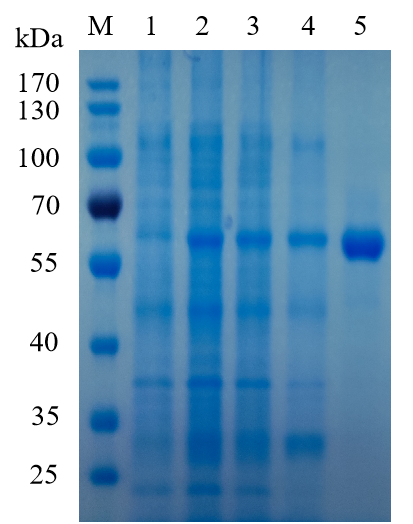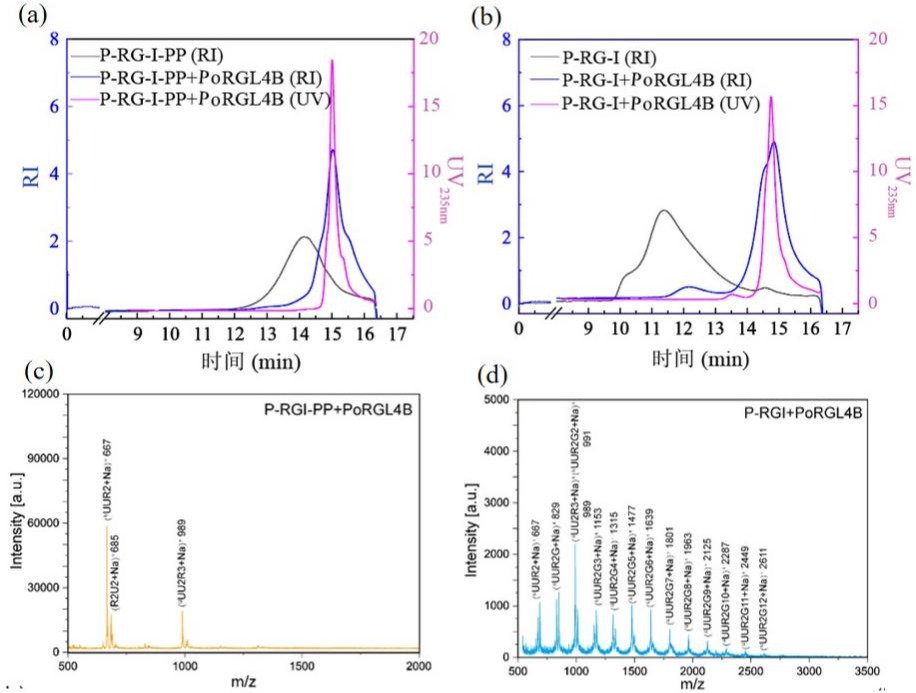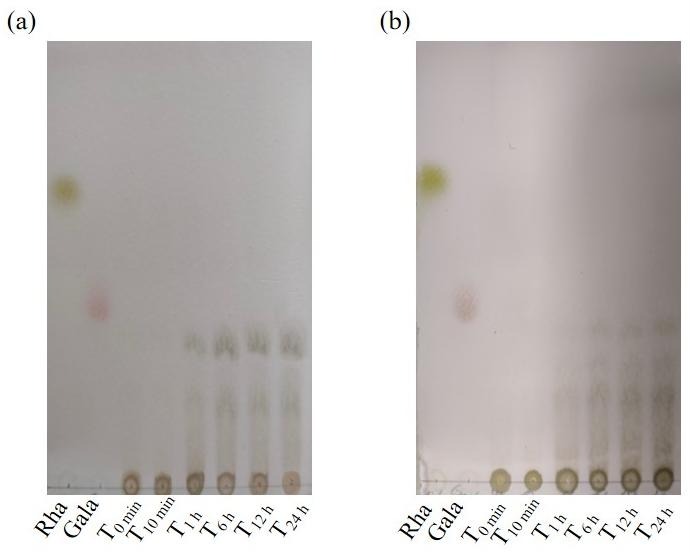PoRgl4B(Rhamnogalacturonan lyase)
PoRgl4B
En-Rgl0339
(EC. 4.2.2.23) Rhamnogalacturonan lyase
CAZy Family: PL4
PROPERTIES
1. ELECTROPHORETIC PURITY
-Single band on SDS-gel electrophoresis (MW ~57 kDa)

Fig 1. Electrophoresis analysis of PoRgl4B. M, molecular weight marker (PageRuler Prestained Protein Ladder, Thermo Scientific); lane 1, culture lysate before methanol induction; lane 2, culture lysate after induction for 24 h; lane 3, culture lysate after induction for 48 h;lane 4, culture lysate after induction for 72 h;lane 5, PoRgl4B purified from Ni sepharose fast flow column.
2. SPECIFIC ACTIVITY
116.3 U/mg protein (on RG-I from Potato) at pH 5.0 and 37°C
One unit of RGL activity was defined as the amount of enzyme required to generate 1 μmol of 4,5-unsaturated galacturonic acid in 1 min.
3. RELATIVE RATES OF HYDROLYSIS OF SUBSTRATES
Table 1 Substrate specificity of PoRGL4B
Substrate |
Structural features |
Relative activity (%)a |
HG |
HG |
0.77±1.70 |
P-RG-I-PP |
RG-I backbone |
100±4.95 |
P-RG-I |
RG-I |
26.2±7.00 |
AT-RG-I |
RG-I |
62.14±9.33 |
PQ-RG-I |
RG-I |
5.41±1.98 |
PG-A |
RG-I |
6.48±3.25 |
PG-B |
RG-I |
12.53±5.09 |
PG-CP |
Galactan |
1.16±2.19 |
SA |
Arabinan+RG-I backbone |
9.91±4.17 |
a Activity toward P-RG-I-PP(potato) is taken as 100%
4. PHYSICOCHEMICAL PROPERTIES
pH Optima: 5.0
pH Stability: 4.0-7.0
Temperature Optima: 40°C
Temperature Stability: 30-50°C

Figure 2. Effect of temperature and pH on the activity and stability of recombinant PoRgl4B. (A) Optimum pH. Assays were carried out at 37°C for 5 min in buffers ranging in pH from 2.0 to 11.0. The activity at optimum pH was defifined as 100%. (B) pH stability. Assays were carried out after the incubation of the enzyme in buffers ranging from pH 2.0-11.0 at 4°C. (C) Optimum temperature. Activity was measured between 20°C and 90°C at pH 5.0 for 5 min. The activity at optimum temperature was defifined as 100%. (D) Thermostability. Assays were carried out in 20 mM HAc-NaAc buffer (pH 5.0) at 37°C for 5 min after the incubation of the enzyme at 30-70°C. The activity without heat treatment was defifined as 100%.

Figure 3. The mode of action of PoRgl4B. HPGPC analysis of the hydrolysis products of P-RG-I-PP(a) and P-RG-I(b) by PoRgl4B. MALDI-TOF-MS analysis the hydrolysis products of P-RG-I-PP(c) and P-RG-I(d) by PoRgl4B.

Figure 4. TLC analysis the hydrolysis products of AT-RG-I and P-RG-I by PoRgl4B.
5. STORAGE CONDITIONS
The enzyme should be stored at -20°C. For assay, this enzyme should be diluted in HAc-NaAc buffer (20 mM) pH 5.0. Swirl to mix the enzyme immediately prior to use.
6. REFERENCE
[1] 孟嘉仪. 草酸青霉中鼠李半乳糖醛酸酶的克隆表达及功能研究[D]. 东北师范大学, 2024.


